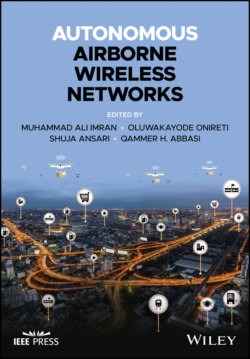Читать книгу Autonomous Airborne Wireless Networks - Группа авторов - Страница 16
2.4 Channel Modeling in UAV Communications
ОглавлениеIn wireless communications, the propagation channel is the free space between the transmitter and the receiver. It is obvious that the performance of wireless networks is influenced by the characteristics of the propagation channel. Therefore, knowledge of wireless channels is pertinent in designing UAV‐enabled networks for future wireless communication. Furthermore, the characterization of radio channel and its modeling for UAV network architecture are crucial for the analysis of network performance.
Majority of the channel modeling efforts is devoted to the terrestrial radio channel with fixed infrastructure. However, these channel models may not be completely suitable for wireless communication using UAVs because of their mobility and small size. The AG channel between the UAV and the ground user implies higher link reliability and requires lower transmission power due to the higher probability of LoS propagation. In the case of NLoS, power variations are more severe because the ground‐based side of the AG link is surrounded by obstacles that adversely affect the propagation. Figure 2.2 depicts the AG propagation channel and shows the distinction between LoS and NLoS components of the channel, with being the propagation distance. Furthermore, temporal variations and the Doppler shift are caused by the UAV mobility. As a result, the arbitrary UAV mobility pattern and operational environment are challenges in modeling the AG channel. Apart from the AG propagation channel, other factors such as airframe shadowing and on‐board antenna placement and characteristics can influence the received power strength.
Figure 2.2 Air‐to‐ground propagation in UAV‐assisted cellular network.
In addition, AA channels between airborne UAVs mostly experience strong LoS similar to the high‐altitude AG channels. However, Doppler shift is higher because UAV mobility is significantly higher and it is difficult to maintain alignment between multiple UAVs.
Accurate AG and AA propagation channel models are imperative for the optimal deployment and the design of the UAV communication networks. This section will discuss recent efforts in the modeling of AG and AA propagation channels.
